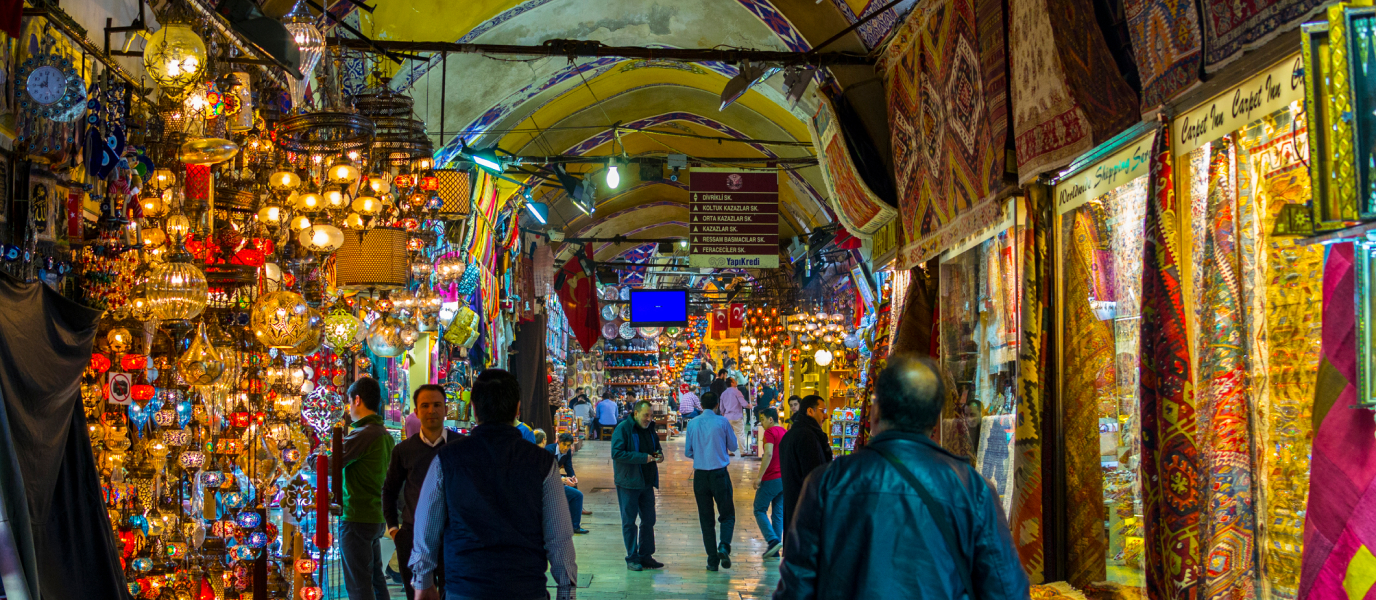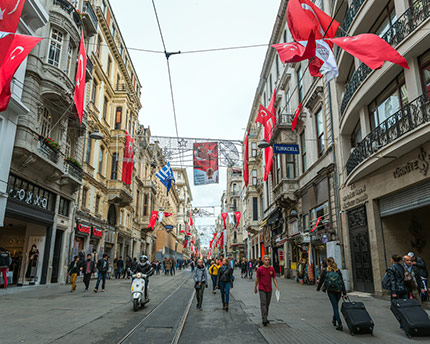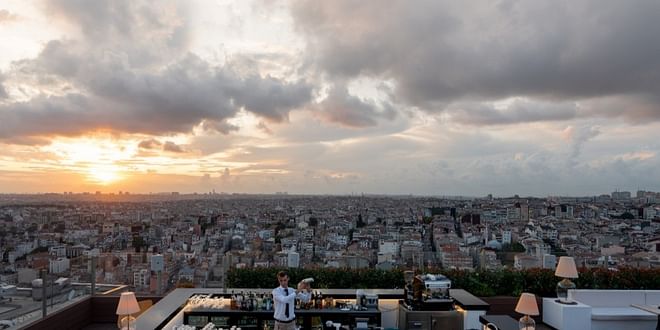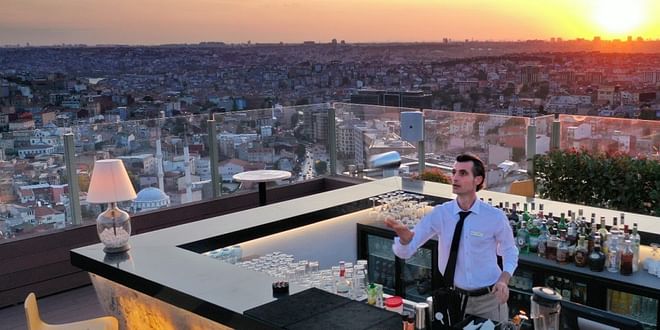Everything is spectacular in the Grand Bazaar, a mythical place in the Turkish metropolis where it’s easy to lose yourself and be amazed. It’s impossible not to think of the tales of The One Thousand and One Nights when you enter this fabulous place that has certainly not lost its special features over time. It can be accessed through up to 22 different doors, leading to some 58 streets. It’s located in the Sultanahmet area, near the Çemberlitas and Beyazit neighbourhoods, just a short distance from the historic centre of the city and its most iconic monuments.
Hundreds of thousands of visitors come every day to explore the labyrinth of shops in this large space where you can buy anything: jewellery, carpets, items made of precious metals, fabrics, etc. It’s impossible not to be dazed by the mixture of sounds, smells, flavours, and colours that fill this magical enclave, which is famous for the haggling that takes place here. If you like spices, be sure to stop by another great shopping area, the Spice Bazaar (internal link).
- The history of Istanbul’s Grand Bazaar, a journey to the Ottoman Empire
- Tips and tricks for getting around the Grand Bazaar
- What to buy in Istanbul’s Grand Bazaar, let’s start with carpets and jewellery
- The pleasure of getting lost and relaxing in a Han
The history of Istanbul’s Grand Bazaar, a journey to the Ottoman Empire
The origin of the Grand Bazaar dates back to the time of Sultan Mehmet II in the 15th century. The ruler started the construction of covered bazaars, known as “bedesten”, which were dedicated to the sale of fabrics and silks. They gradually included other types of products. The guild workshops were grouped by zones and over time the streets that housed them were covered by vaults, leading to the appearance of the Grand Bazaar as we know it today.
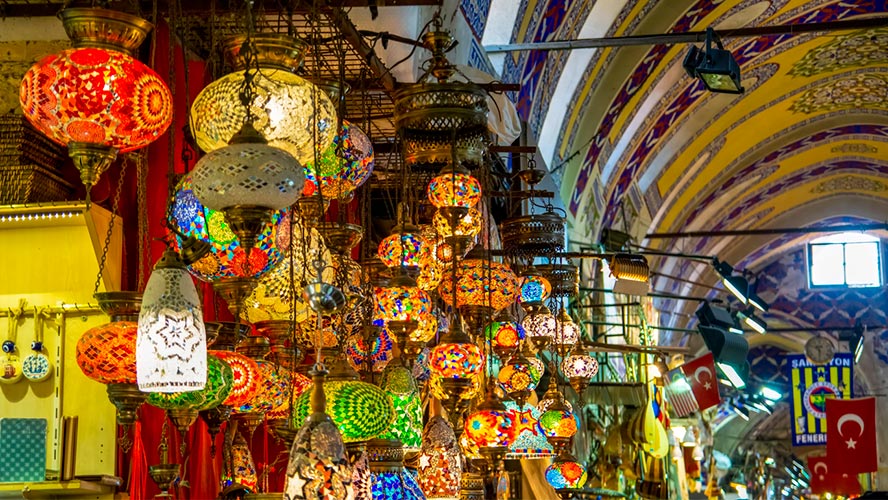
The distribution of the shops by specialisation is still in place and is one of the bazaar’s distinguishing features. The entrance gates, up to 22 in all, lead to different sales areas. If you know the entrances, it’s easy to reach the places where you can buy jewellery, carpets, ceramics, footwear, clothing, food, handicrafts, spices, and so on.
It’s easy to travel back in time when touring this city of treasures within Istanbul. The vast expanse of the Ottoman Empire across three continents and its control of communications between Asia and Europe made the Grand Bazaar a major economic hub for Mediterranean trade. According to various travellers’ and chroniclers’ sources, until about the mid-19th century, the huge market was unrivalled among its European peers due to the abundance, variety, and quality of its products.
The various eras of Istanbul’s Grand Bazaar
The architecture of the site still has its main features, but many disasters have afflicted the area. Fires and earthquakes over the years have meant that various refurbishments were required. Its present form, with its 45,000 square metres of floor space, is the result of improvements made after an earthquake in 1984.
The shops of the Grand Bazaar have been much more than places for business transactions. In the past, they were places to meet and talk. The merchants sat on wooden sofas in front of their small shelves, and customers could sit next to them and chat over a cup of Turkish tea or coffee. Talk would centre around the products, but there was also time to discuss many other matters. In some places this custom is still alive and you can still see shopkeepers offering an apple tea to customers in less of a hurry.
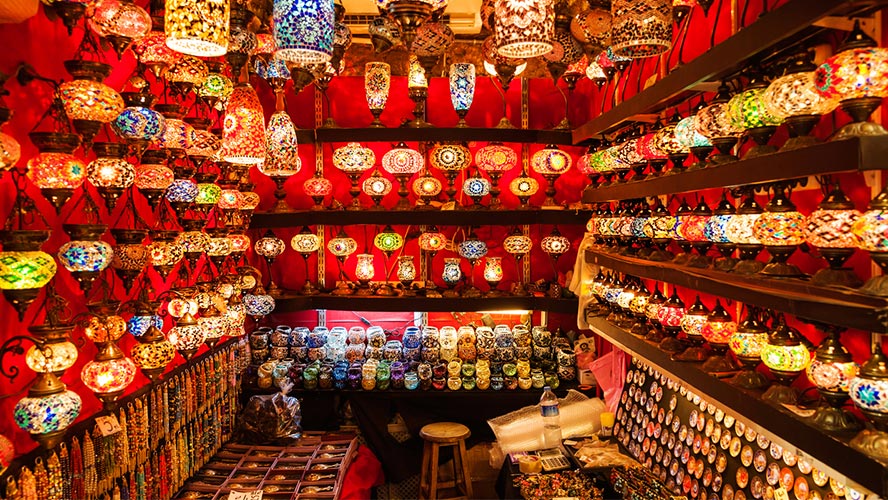
More than 10,000 people work in the Grand Bazaar today. Its enthusiastic salesmen are known not only for their haggling skills, but also for their command of languages to better serve customers.
Tips and tricks for getting around the Grand Bazaar
In a place like Istanbul’s Grand Bazaar, the first thing to do is to be patient and cautious. When you’re in front of the world’s most seasoned vendors, genuine snake charmers, it’s a good idea to be very clear about what you want to buy. Those who find the art of haggling exhilarating will have a great time here, but be careful, as you may leave with your hands so full that you’ll have to buy new suitcases for the return trip.
Shopkeepers in Turkey are generally quite respectful. They’re not as pushy as in other countries. Buyers do best when they’re friendly and relaxed, especially if they have a talent for conversation and flattery. It’s advisable to start haggling when you’re genuinely interested in the purchase and to not back down after the price has been agreed. Doing so is a serious offence.
A trick that often works is to offer a starting amount to the trader. This is a good way to start negotiating. And you also get better results when you don’t show too much interest. The sellers are very skilful and if they sense that you really want the product, they’ll ask a very high price. If you know how to haggle, they may even drop the price down to half the initial figure.
If there’s no sign you’ll get a discount, the rules of haggling suggest that you should say that you give up. The seller is then likely to agree to offer the item for a lower amount. You should also bear in mind that if you buy more than one of the same product, you’ll save money. And you should carry cash for small purchases and leave the credit card for bigger purchases such as jewellery or carpets.
What to buy in Istanbul’s Grand Bazaar, let’s start with carpets and jewellery
What can’t you find in the Grand Bazaar? You can find almost everything in this magnificent market, which is one of the oldest in the world, but there are certain areas where the Turks are masters. This is certainly the case with carpets. The quality of their carpets is world-renowned. One of their main features is the way they’re woven, with double knots. You have to have time and go from shop to shop to find the perfect piece at the best price (internal link: What to buy in Istanbul). You have to haggle patiently.
There are also many jewellery shops that are a delight for visitors. They’re often very expensive, but it’s always possible to get your hands on stunning gold, silver, emerald and ruby necklaces, rings, earrings, and brooches of all kinds for less than in other places where haggling is frowned upon.
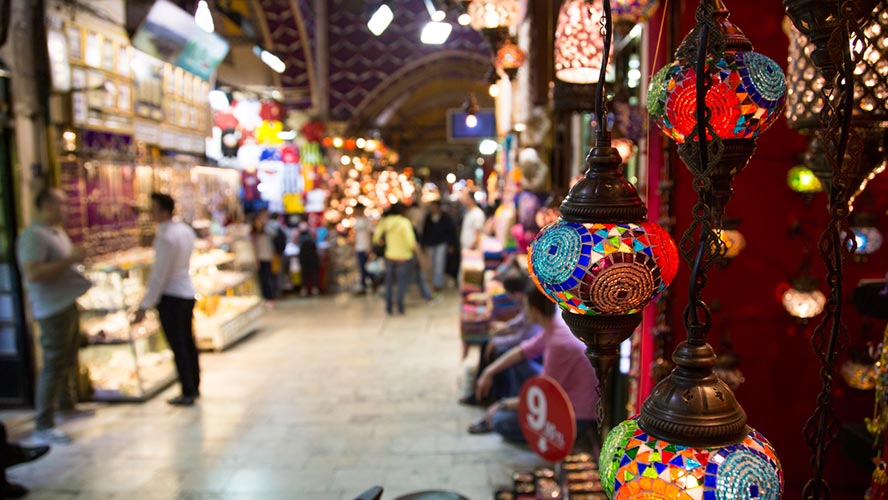
Clothing, footwear, handbags, handicrafts, souvenirs, and spices
Bags, clothes and shoes are also a big attraction in the Grand Bazaar. You can find both originals and well-made fakes. Leather jackets and belts are highly sought after by visitors. If you’re on a tight budget, you can always pick up a souvenir. Or a small item made from a precious metal or a handicraft.
Natural soaps and sponges, as well as beautifully coloured organic cotton towels, are other sought-after products in the market. In the Grand Bazaar, you can also find traditional Turkish sweets (internal link: typical Turkish food) and all kinds of spices.
The pleasure of getting lost and relaxing in a Han
Even if shopping is not your aim, visiting the Grand Bazaar in Istanbul can be a delightful experience as long as you’re not in a hurry and enjoy taking in the ambience of the surroundings and losing yourself. The hustle and bustle of the people, the gestures of the vendors, the reflections of the jewellery shops and the architecture of the place itself, with its domes painted blue, are reason enough to take the time to wander around.
Nor should we forget the small courtyards that are found in this immense flea market. They’re called Hans and it’s very enjoyable to take a break from the hustle and bustle of shopping, have a bite to eat and regain your strength to return to the search for the items you want. There’s a very special one, the Zincirli Han. Inside is one of the most famous carpet shops in the Grand Bazaar.

























































